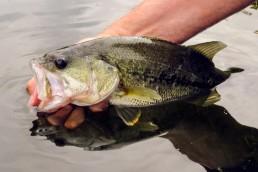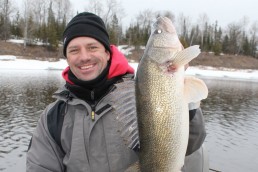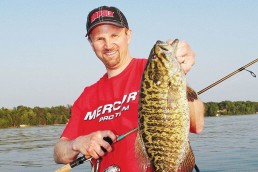Moving Out on Early-season Bass
SHARE THIS POST
It was one of those glorious early season days you know it was all worth getting through winter for. It was bright and warm with light winds. My wife, Becky, and I were fishing in shorts and t-shirts.
We were fishing a small lake in Wisconsin’s Polk County. It had been a long and brutal winter, which stretched into spring. The water was still cold, so I thought the fish would be in shallow water where the sun would make the water a bit warmer. That was the theory anyway.
We fished sinking plastic worms, tossing them close to the bank. Bass should have been there. After working a couple hundred yards of shoreline, neither of us had a strike. It made me question the validity of my theory. Fish obviously weren’t in shallow, warmer water. It has always been my belief if you can’t find fish shallow, then they must be deep.
Changing tactics
“I think we need a change in tactics,” I told my wife.
“What do you have in mind?” She asked.
“Let’s move out a bit and fish deeper water,” I suggested as I was pulling out another spinning rod with a crankbait on it out of the rod locker.
“I think I will stay with the worm,” she told me.
I moved out another 30 feet. Checking the depth finder on the front of the boat, I saw we were in 15 feet of water. The crankbait landed about a boat length from the bank and I brought it back with a steady retrieve. Within half a dozen casts, my bait jolted to a stop. My spinning rod was doubled over as the fish ran off. I turned the fish, but it fought hard and never gave up… even when it was splashing alongside the boat. Reaching over I hauled the fish into the boat. It was a fat, 14-inch largemouth bass.
One fish was all Becky needed to see. She quickly changed to a crankbait. Within a couple of minutes, a fish slammed her bait when it was halfway back to the boat. The fish stayed deep, putting up a spectacular fight by the time she got it alongside the boat for me to grab it. It was a 15-inch bass.
Are you enjoying this post?
You can be among the first to get the latest info on where to go, what to use and how to use it!
Catching on every cast
On her next cast, she caught another bass. She had two fish in two casts. Then she caught her third and fourth fish. I still hadn’t had another strike. A few minutes later, she just set the hook on another fish when I felt a fish charging away with my bait. My fish swirled on the surface and dove deep, putting up a strong battle, pulling line off the drag before we both got our fish near the boat so we could pull them in. We had a double, both caught a fish at the same.
Any number of baits will work for early season, deep-water bass. My first choice is usually crankbaits. Fish will be aggressively feeding. A fast-moving bait, such as crankbaits, will generate strikes.
My favorite crankbait is the number five Jointed Shad Rap by Rapala. Although color probably doesn’t matter, my favorite is the blue shad. Another good early season crankbait I use is the number five Salmo Hornet in their dace blue color. Although I tend to go for blue colors, other colors—such as silver or minnow-type color—will work as well as chartreuse or firetiger if the water is stained or dirty. Crawdad colors will also be effective as bass look at crawfish the way we look at lobsters.
Another good deep-water bait for early season is the lipless crankbait. There are any number of them, but my favorite is the Rattlin Rapala. It is a sinking bait. I just cast it out, letting it sink for a couple seconds before I start my retrieve. Lipless crankbaits have a tight movement fish find enticing. Again, my favorite color is blue shad. I also like the bone color which is an off white with an orange belly.
An easy, no-frills bait
No matter which crankbait you are using they are easy to work. You don’t need anything fancy here. The fish are feeding aggressively. A steady retrieve is all you will need.
Becky pulled back on her spinning rod. The fish didn’t move at first. “This is a big fish,” she yelled at me. Then the fish exploded in a mad dash. Her reel was giving out line as the fish fought the drag. She turned the fish each time, but the fish refused to give in and charged off one again. I got out the net, waiting for Becky to get the fish close. Finally, we saw it three or four feet below the surface as it tried to take off again. Becky pulled back on her spinning rod and the fish was next to the boat. She led the fish into the net as I lifted up. The fish showed it wasn’t ready to give up yet as it thrashed and twisted in the mesh.
I pulled the fish out and measured it. It was a 17-inch bass and would be the biggest fish of the day. It was an incredible day of fishing. We caught 38 fish. Four of them were northern pike and the rest bass measuring from 14 to 17 inches. All of them came from deep water on crankbaits.
For the best in early season bass fishing, it pays to move out from the bank and work deeper water with crankbaits.
MWO
SHARE THIS POST
Did you enjoy this post?
You can be among the first to get the latest info on where to go, what to use and how to use it!
Mike Yurk
Mike Yurk grew up in Oshkosh, Wis., where he first started writing about the outdoors. A retired Army officer, he is now a full-time, freelance outdoor writer. He has written more than 1000 articles for outdoor publications and published 12 books on outdoor sports. He lives in northwestern Wisconsin where he has found some of the best bass fishing in the country.



